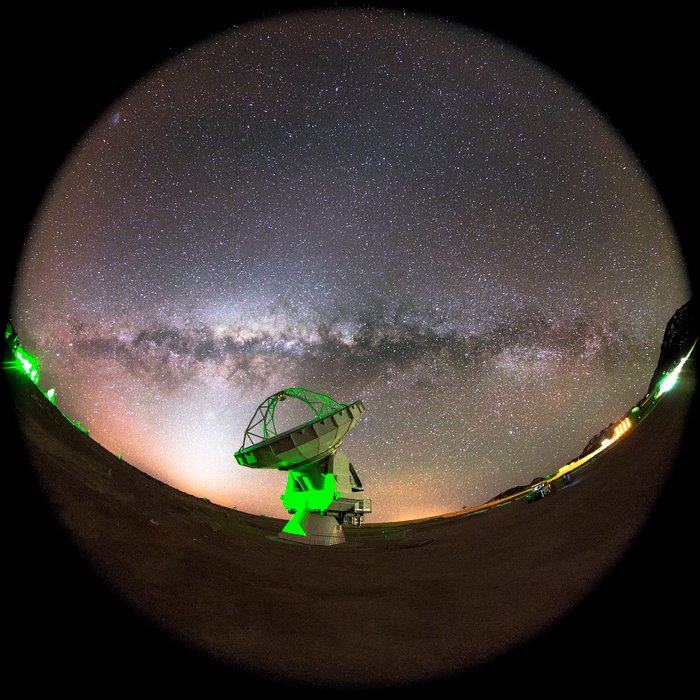Pushing the limits with ALMA
In the background, we can see in this fish-eye fulldome view, the arm of Milky Way full of gas and dust with the Zodiacal Light crossing the sky. In the foreground, is also visible one antenna (DV-21) of 12 meters in diameter, pointing to some place of the cold Universe. This are the first tests to experiment the largest configuration that ALMA can support, with antennas spread over distances up to 16 km. The array thus simulates a giant, single telescope much larger than any that could actually be built. In fact, ALMA has a maximum resolution which is even better than that achieved, at visible wavelengths, by the Hubble Space Telescope. The Atacama Large Millimeter/submillimeter Array (ALMA) is an astronomical interferometer of radio telescopes in the Atacama desert of northern Chile. Since a high and dry site is crucial to millimeter wavelength operations, the array has been constructed on the Chajnantor plateau at 5,000 meters altitude, near Llano de Chajnantor Observatory and Atacama Pathfinder Experiment. Consisting of 66 12-meter (39 ft), and 7-meter (23 ft) diameter radio telescopes observing at millimeter and submillimeter wavelengths, ALMA is expected to provide insight on star birth during the early universe and detailed imaging of local star and planet formation. ALMA is a single telescope of revolutionary design, composed initially of 66 high-precision antennas, and operating at wavelengths of 0.32 to 3.6 mm. Its main 12-metre array has fifty antennas, 12 metres in diameter, acting together as a single telescope — an interferometer. An additional compact array of four 12-metre and twelve 7-metre antennas complements this. The 66 ALMA antennas can be arranged in different configurations, where the maximum distance between antennas can vary from 150 metres to 16 kilometres, which will give ALMA a powerful variable “zoom”. It will be able to probe the Universe at millimetre and submillimetre wavelengths with unprecedented sensitivity and resolution, with a vision up to ten times sharper than the Hubble Space Telescope, and complementing images made with the VLT Interferometer. Light at these wavelengths comes from vast cold clouds in interstellar space, at temperatures only a few tens of degrees above absolute zero, and from some of the earliest and most distant galaxies in the Universe. Astronomers can use it to study the chemical and physical conditions in molecular clouds — the dense regions of gas and dust where new stars are being born. Often these regions of the Universe are dark and obscured in visible light, but they shine brightly in the millimetre and submillimetre part of the spectrum. ALMA is the most powerful telescope for observing the cool Universe — molecular gas and dust. ALMA will study the building blocks of stars, planetary systems, galaxies and life itself. By providing scientists with detailed images of stars and planets being born in gas clouds near our Solar System, and detecting distant galaxies forming at the edge of the observable Universe, which we see as they were roughly ten billion years ago, it lets astronomers address some of the deepest questions of our cosmic origins.
Bildnachweis:ESO/M. Claro
Über das Bild
| ID: | allsky-5792-cc |
| Typ: | Fotografisch |
| Veröffentlichungsdatum: | 15. Juni 2016 12:15 |
| Größe: | 3602 x 3603 px |
Über das Objekt
| Name: | Atacama Large Millimeter/submillimeter Array |
| Typ: | Unspecified : Technology : Observatory : Telescope |
| Kategorie: | ALMA Fulldome |
